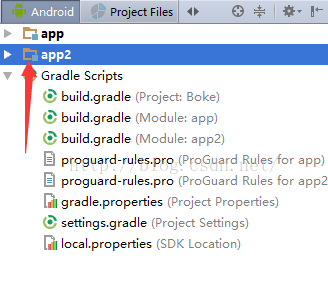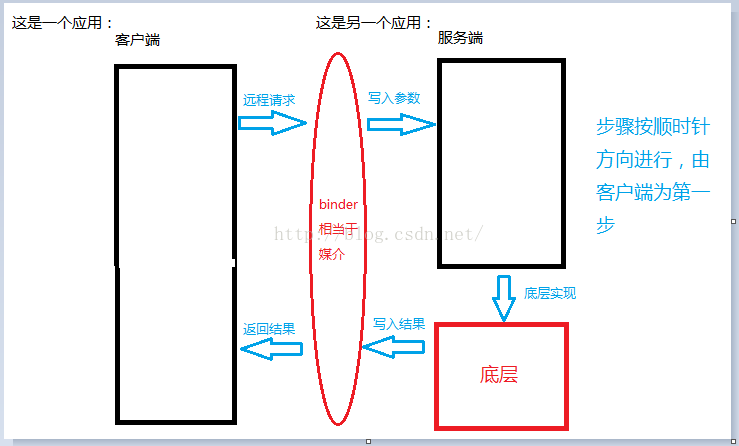Android基础——初学者必知的AIDL在应用层上的Binder机制
初学者必知的AIDL在应用层上的Binder机制
首先得理解几个概念:
IPC:Inter-Process Communication,进程间的通信或跨进程通信。简单点理解,一个应用可以存在多个进程,但需要数据交换就必须用IPC;或者是二个应用之间的数据交换。
Binder:Binder是Android的一个类,它实现了IBinder接口。从IPC角度来说,Binder是Android中的一种跨进程通信方式。通过这个Binder对象,客户端就可以获取服务端提供的服务或数据,这里的服务包括普通服务和基于AIDL的服务。
AIDL:Android Interface Definition language,它是一种Android内部进程通信接口的描述语言。
一、AIDL的使用
服务端:
创建一个服务端工程,在工程中点击右键New->AIDL->AIDL File,默认直接点确定,这时会在工程中出现一个aidl文件:
我们打开这个aidl文件,我们创建一个我们需要测试的方法:
由于Android Studio是要手动编译才能生成对应AIDL的java文件,既然aidl文件是个接口,那就必须存在着实现这个接口的类,点击编译,系统自动生成一个java类,该java类的代码就是整个Binder机制的原理所在(会在下面第二步骤介绍原理):
既然是个服务端,那么我们就要开始写服务了,创建一个类,继承Service:
import android.app.Service;
import android.content.Intent;
import android.os.IBinder;
import android.os.RemoteException;
import android.support.annotation.Nullable;
import android.util.Log;
import com.handsome.boke.IMyAidlInterface;
public class MyService extends Service {
@Nullable
@Override
public IBinder onBind(Intent intent) {
return myS;
}
private IBinder myS = new IMyAidlInterface.Stub() {
@Override
public void basicTypes(int anInt, long aLong, boolean aBoolean, float aFloat, double aDouble, String aString) throws RemoteException {
}
@Override
public int add(int num1, int num2) throws RemoteException {
Log.i("Hensen", "从客户端发来的AIDL请求:num1->" + num1 + "::num2->" + num2);
return num1 + num2;
}
};
}既然是个服务,就必须在manifests文件中配置:
public class LoginActivity extends AppCompatActivity {
@Override
protected void onCreate(Bundle savedInstanceState) {
super.onCreate(savedInstanceState);
setContentView(R.layout.activity_login);
startService(new Intent(this, MyService.class));
}
}客户端:
在工程中点击右键New->Module,按默认确定,finish:

关键的一步来了,复制服务端的aidl整个文件夹(包括里面的包、aidl文件、完整无缺)粘贴到客户端对应放aidl的地方:
好了我们来写客户端的代码(我们在MainActivity中放一个”AIDL“的按钮,先绑定服务,然后点击按钮调用):
public class MainActivity extends AppCompatActivity {
IMyAidlInterface iMyAidlInterface;
@Override
protected void onCreate(Bundle savedInstanceState) {
super.onCreate(savedInstanceState);
setContentView(R.layout.activity_main);
//绑定服务
Intent intent = new Intent();
intent.setComponent(new ComponentName("com.handsome.boke", "com.handsome.boke.Aidl.MyService"));
bindService(intent, conn, BIND_AUTO_CREATE);
}
/**
* 点击“AIDL”按钮事件
*
* @param view
*/
public void add(View view) {
try {
int res = iMyAidlInterface.add(1, 2);
Log.i("Hensen", "从服务端调用成功的结果:" + res);
} catch (RemoteException e) {
e.printStackTrace();
}
}
/**
* 服务回调方法
*/
private ServiceConnection conn = new ServiceConnection() {
@Override
public void onServiceConnected(ComponentName name, IBinder service) {
iMyAidlInterface = IMyAidlInterface.Stub.asInterface(service);
}
@Override
public void onServiceDisconnected(ComponentName name) {
iMyAidlInterface = null;
}
};
@Override
protected void onDestroy() {
super.onDestroy();
//解绑服务,回收资源
unbindService(conn);
}
}
08-19 10:59:34.548 6311-6328/com.handsome.boke I/Hensen: 从客户端发来的AIDL请求:num1->1::num2->208-19 10:59:34.550 7052-7052/com.handsome.app2 I/Hensen: 从服务端调用成功的结果:3二、AIDL的Binder机制原理分析
分析原理:
/*
* This file is auto-generated. DO NOT MODIFY.
* Original file: D:\\workspace5\\Boke\\app\\src\\main\\aidl\\com\\handsome\\boke\\IMyAidlInterface.aidl
*/
package com.handsome.boke;
// Declare any non-default types here with import statements
public interface IMyAidlInterface extends android.os.IInterface {
/**
* Local-side IPC implementation stub class.
*/
public static abstract class Stub extends android.os.Binder implements com.handsome.boke.IMyAidlInterface {
private static final java.lang.String DESCRIPTOR = "com.handsome.boke.IMyAidlInterface";
/**
* Construct the stub at attach it to the interface.
*/
public Stub() {
this.attachInterface(this, DESCRIPTOR);
}
/**
* Cast an IBinder object into an com.handsome.boke.IMyAidlInterface interface,
* generating a proxy if needed.
*/
public static com.handsome.boke.IMyAidlInterface asInterface(android.os.IBinder obj) {
if ((obj == null)) {
return null;
}
android.os.IInterface iin = obj.queryLocalInterface(DESCRIPTOR);
if (((iin != null) && (iin instanceof com.handsome.boke.IMyAidlInterface))) {
return ((com.handsome.boke.IMyAidlInterface) iin);
}
return new com.handsome.boke.IMyAidlInterface.Stub.Proxy(obj);
}
@Override
public android.os.IBinder asBinder() {
return this;
}
@Override
public boolean onTransact(int code, android.os.Parcel data, android.os.Parcel reply, int flags) throws android.os.RemoteException {
switch (code) {
case INTERFACE_TRANSACTION: {
reply.writeString(DESCRIPTOR);
return true;
}
case TRANSACTION_basicTypes: {
data.enforceInterface(DESCRIPTOR);
int _arg0;
_arg0 = data.readInt();
long _arg1;
_arg1 = data.readLong();
boolean _arg2;
_arg2 = (0 != data.readInt());
float _arg3;
_arg3 = data.readFloat();
double _arg4;
_arg4 = data.readDouble();
java.lang.String _arg5;
_arg5 = data.readString();
this.basicTypes(_arg0, _arg1, _arg2, _arg3, _arg4, _arg5);
reply.writeNoException();
return true;
}
case TRANSACTION_add: {
data.enforceInterface(DESCRIPTOR);
int _arg0;
_arg0 = data.readInt();
int _arg1;
_arg1 = data.readInt();
int _result = this.add(_arg0, _arg1);
reply.writeNoException();
reply.writeInt(_result);
return true;
}
}
return super.onTransact(code, data, reply, flags);
}
private static class Proxy implements com.handsome.boke.IMyAidlInterface {
private android.os.IBinder mRemote;
Proxy(android.os.IBinder remote) {
mRemote = remote;
}
@Override
public android.os.IBinder asBinder() {
return mRemote;
}
public java.lang.String getInterfaceDescriptor() {
return DESCRIPTOR;
}
/**
* Demonstrates some basic types that you can use as parameters
* and return values in AIDL.
*/
@Override
public void basicTypes(int anInt, long aLong, boolean aBoolean, float aFloat, double aDouble, java.lang.String aString) throws android.os.RemoteException {
android.os.Parcel _data = android.os.Parcel.obtain();
android.os.Parcel _reply = android.os.Parcel.obtain();
try {
_data.writeInterfaceToken(DESCRIPTOR);
_data.writeInt(anInt);
_data.writeLong(aLong);
_data.writeInt(((aBoolean) ? (1) : (0)));
_data.writeFloat(aFloat);
_data.writeDouble(aDouble);
_data.writeString(aString);
mRemote.transact(Stub.TRANSACTION_basicTypes, _data, _reply, 0);
_reply.readException();
} finally {
_reply.recycle();
_data.recycle();
}
}
@Override
public int add(int num1, int num2) throws android.os.RemoteException {
android.os.Parcel _data = android.os.Parcel.obtain();
android.os.Parcel _reply = android.os.Parcel.obtain();
int _result;
try {
_data.writeInterfaceToken(DESCRIPTOR);
_data.writeInt(num1);
_data.writeInt(num2);
mRemote.transact(Stub.TRANSACTION_add, _data, _reply, 0);
_reply.readException();
_result = _reply.readInt();
} finally {
_reply.recycle();
_data.recycle();
}
return _result;
}
}
static final int TRANSACTION_basicTypes = (android.os.IBinder.FIRST_CALL_TRANSACTION + 0);
static final int TRANSACTION_add = (android.os.IBinder.FIRST_CALL_TRANSACTION + 1);
}
/**
* Demonstrates some basic types that you can use as parameters
* and return values in AIDL.
*/
public void basicTypes(int anInt, long aLong, boolean aBoolean, float aFloat, double aDouble, java.lang.String aString) throws android.os.RemoteException;
public int add(int num1, int num2) throws android.os.RemoteException;
}
我们来分析一下这个类
首先本身继承Iinterface,所以他也是个接口,接口中必须有方法,代码定位到结尾有2个方法。
public void basicTypes(int anInt, long aLong, boolean aBoolean, float aFloat, double aDouble, java.lang.String aString) throws android.os.RemoteException;
public int add(int num1, int num2) throws android.os.RemoteException;接着发现该接口中有1个内部类Stub,继承自本身(IMyAidlInterface)接口,代码定位到Stub类。
这个Stub有个构造方法、asInterface、asBinder、onTransact(先不介绍)。
接着发现该内部类Stub还有一个内部类,代码定位到Proxy(我们把它称为代理)类,也是继承自本身(IMyAidlInterface)接口,所以实现该接口的两个方法。
/**
* Demonstrates some basic types that you can use as parameters
* and return values in AIDL.
*/
@Override
public void basicTypes(int anInt, long aLong, boolean aBoolean, float aFloat, double aDouble, java.lang.String aString) throws android.os.RemoteException {
android.os.Parcel _data = android.os.Parcel.obtain();
android.os.Parcel _reply = android.os.Parcel.obtain();
try {
_data.writeInterfaceToken(DESCRIPTOR);
_data.writeInt(anInt);
_data.writeLong(aLong);
_data.writeInt(((aBoolean) ? (1) : (0)));
_data.writeFloat(aFloat);
_data.writeDouble(aDouble);
_data.writeString(aString);
mRemote.transact(Stub.TRANSACTION_basicTypes, _data, _reply, 0);
_reply.readException();
} finally {
_reply.recycle();
_data.recycle();
}
}
@Override
public int add(int num1, int num2) throws android.os.RemoteException {
android.os.Parcel _data = android.os.Parcel.obtain();
android.os.Parcel _reply = android.os.Parcel.obtain();
int _result;
try {
_data.writeInterfaceToken(DESCRIPTOR);
_data.writeInt(num1);
_data.writeInt(num2);
mRemote.transact(Stub.TRANSACTION_add, _data, _reply, 0);
_reply.readException();
_result = _reply.readInt();
} finally {
_reply.recycle();
_data.recycle();
}
return _result;
}
}
static final int TRANSACTION_basicTypes = (android.os.IBinder.FIRST_CALL_TRANSACTION + 0);
static final int TRANSACTION_add = (android.os.IBinder.FIRST_CALL_TRANSACTION + 1);
/**
* 服务回调方法
*/
private ServiceConnection conn = new ServiceConnection() {
@Override
public void onServiceConnected(ComponentName name, IBinder service) {
iMyAidlInterface = IMyAidlInterface.Stub.asInterface(service);
}
@Override
public void onServiceDisconnected(ComponentName name) {
iMyAidlInterface = null;
}
};
public static com.handsome.boke.IMyAidlInterface asInterface(android.os.IBinder obj) {
if ((obj == null)) {
return null;
}
android.os.IInterface iin = obj.queryLocalInterface(DESCRIPTOR);
if (((iin != null) && (iin instanceof com.handsome.boke.IMyAidlInterface))) {
return ((com.handsome.boke.IMyAidlInterface) iin);
}
return new com.handsome.boke.IMyAidlInterface.Stub.Proxy(obj);
}
return new com.handsome.boke.IMyAidlInterface.Stub.Proxy(obj);
int res = iMyAidlInterface.add(1, 2);@Override
public int add(int num1, int num2) throws android.os.RemoteException {
android.os.Parcel _data = android.os.Parcel.obtain();
android.os.Parcel _reply = android.os.Parcel.obtain();
int _result;
try {
_data.writeInterfaceToken(DESCRIPTOR);
_data.writeInt(num1);
_data.writeInt(num2);
mRemote.transact(Stub.TRANSACTION_add, _data, _reply, 0);
_reply.readException();
_result = _reply.readInt();
} finally {
_reply.recycle();
_data.recycle();
}
return _result;
}
mRemote.transact(Stub.TRANSACTION_add, _data, _reply, 0);case TRANSACTION_add: {
data.enforceInterface(DESCRIPTOR);
int _arg0;
_arg0 = data.readInt();
int _arg1;
_arg1 = data.readInt();
int _result = this.add(_arg0, _arg1);
reply.writeNoException();
reply.writeInt(_result);
return true;
}
int _result = this.add(_arg0, _arg1);
reply.writeNoException();
reply.writeInt(_result);
return super.onTransact(code, data, reply, flags);
int res = iMyAidlInterface.add(1, 2);最后总结下整个过程

三、AIDL编写时候的一些错误
错误一:
Caused by: java.lang.NullPointerException: Attempt to invoke interface method 'int com.handsome.boke.IMyAidlInterface.add(int, int)' on a null object reference
@Override
public IBinder onBind(Intent intent) {
return null;
}错误二:
Caused by: java.lang.SecurityException: Not allowed to bind to service Intent { cmp=com.handsome.boke/.Aidl.MyService }






